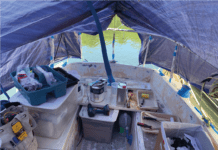Inspired by Technical Editor Drew Frye’s dive into sailing shoe durability this month, I recently rummaged through Practical Sailor’s Gear Graveyard to see what I could find. To descend into a world haunted by the ghosts of sailing gear that didn’t live up to expectations seemed somehow appropriate as Halloween approached. The “graveyard” is actually a half-dozen labeled Rubbermaid tubs in our workshop where we store broken stuff to be examined and included in future reports. A lot of the gear comes from readers who are fed up with wasting their money on “marine-grade” equipment that fails to make the grade.
Anytime I sift through the graveyard—PFDs that are flaking apart, bilge pumps that refuse to pump, safety harness clips that are locked tight—I’m always amazed by how little has changed. A bilge pump today doesn’t look very different from one 40 years ago. Cheap hose clamps still have mild steel screws that seemingly corrode overnight, and shoes, even the most expensive brands, have soles that harden beyond repair after just a few seasons.
I have contributed five pairs of shoes and a pair of sailing boots to the bin myself—all of them have perfectly comfortable uppers and plenty of tread left on the sole, but the sole has become brittle and hard, even cracking in places. My own shoe-fails keep company with three other pairs, including a pair of Harken sailing H2000 shoes sent to us by reader George Sparr more than a decade ago. At the time he bought them, they were among our recommended models.
“This is the second pair that I have purchased from Harken with the same defect, the soles get very hard and extremely smooth . . . They suggested sanding the surface, but for what I paid for them, I don’t feel like I should have to jury rig the soles.”
This isn’t just a Harken problem. Sperry, Helly Hansen, Sebago, Columbia, Rockport . . . you name it. While the uppers, and mid-soles, and even the tread are still intact, the sole bottom becomes hard, almost brittle, after a three to five years. Plastic fantastic, it is not.
My solution has been to put all my effort into improving the non-skid on Opal, my 1971 Yankee 30, look for soles that I can dig a fingernail into, and to wear my shoes out before they turn hard. It’s important to test for grip before you buy. Amazingly, Frye found sailing shoes with soles that were rock hard and slippery right out of the box.
How long will my shoes last? I’m hopeful. The good news is that there’s some truth in Harken’s advice to Mr. Sparr. If you carefully machine-sand the bottom of your $100 sailing shoes, you’ll extend them by another season, maybe two. And if you use them regularly, the everyday wear will expose new soft sole that grips better. But that will only help for the first three years or so; after that, the plastic deteriorates and you are out of luck. All the shoes in the Gear Graveyard bin have soles that are not only slick, but crack when they flex.
In truth, I’m not surprised. As our shoe testing has shown over the years, in throw-away world where there’s little incentive to make footwear that can be affordably reconditioned, there are very few sole survivors.










































